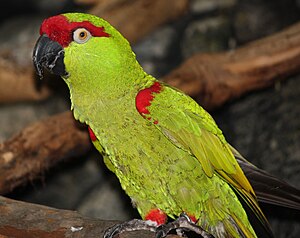Macaw parakeet
| Macaw parakeet | ||||||||||
|---|---|---|---|---|---|---|---|---|---|---|

Macaw Parakeet ( Rhynchopsitta pachyrhyncha ) |
||||||||||
| Systematics | ||||||||||
|
||||||||||
| Scientific name | ||||||||||
| Rhynchopsitta pachyrhyncha | ||||||||||
| ( Swainson , 1827) |
The Macaw Parrot ( Rhynchopsitta pachyrhyncha ) is a dove- sized New World parrot widespread in western Mexico . Its exact distribution area is in the Sierra Madre Occidental from Chihuahua to Michoacán . The birds used to live in the southwestern United States. A reintroduction attempt was in 1986 in the Chiricahua Mountains in Arizona made with 50 seized by customs Arasittichen. Although the animals have reproduced, no stable population could be established. A small number of macaw parakeets still live north of the border.
features
Macaw parakeets resemble Amazons and, like them, are green in color. The forehead, a stripe above the eyes, the front parting, the bend of the wing and the feathers of the thighs are red. The beak is black, the wax skin gray, a ring around the eyes is white-yellow and the iris is yellow-orange. The feet are dark gray to blackish. Macaw parakeets reach a length of 38 cm.
Young birds show less red, their wing bend is green, the red headband is narrower. Their bill is horn-colored and their irises are brown.
With their long, pointed wings they have a hawk-like flight pattern . They are fast fliers who can avoid fast birds of prey such as the hawk and the peregrine falcon . During long flights, they assume a V-shaped flight formation, similar to geese.
habitat
Macaw parakeets live in coniferous forests at altitudes of 1500 to 3500 meters. In winter they move to deeper and more southern regions. They rarely stay below 2000 meters. The temperatures in their habitat are mostly between 10 and 25 ° C. From July to September there are almost daily showers. In the forests there are mainly pines , but also Douglas firs , poplars and oaks .
Lifestyle and diet
Macaw parakeets mainly eat pine seeds, but also live on acorns, corn, fruits, green plants and nectar. They look for their food both in the trees and on the ground. Depending on the food supply, the birds wander far and wide. They live in pairs or in groups that can be several hundred animals strong. They tend to spend the night in large groups, while during the day they split up into small groups to search for food. When foraging for food, they cover distances of up to 40 km. Couples always fly together at a distance of two to three meters.
Vocalizations
Like many parrots, macaws are very noisy animals that enjoy calling. They call during the flight. In a group, one or two birds will make soft or harsh calls every five to ten seconds. The same calls are heard while searching for food, but less often. The calls can be heard under favorable conditions up to a distance of 1.5 to three kilometers. While they are grooming each other, they make chattering noises. Sounds that sound like laughter, such as “kah ha” and “kah ha ha ha ha ha”, and a sharp “krak krak krak” can also be heard.
Reproduction
Macaw parakeets breed between mid-June and late July at altitudes of 2300 to 3125 meters in the northern part of their range. They build their nests in tree hollows, also in old woodpecker hollows, at heights between eight and 28 meters. They enlarge the entrance and the interior of the cave. The average inside diameter is 27 cm. The two to four eggs (dimensions approx. 30.6 × 39.5 mm) are placed on a base made of wood chips. The couples sleep together in the cave. The eggs are incubated for about 28 days until the young are hatched. After the young have hatched, the female remains in the cave with the young for 20 days and is fed with the young every three to five hours by the male. After ten weeks, the young birds are fully fledged.
Danger
The populations of macaw parakeets have declined sharply in recent years. The main cause is the lack of breeding trees caused by deforestation.
literature
- Werner Lantermann: parrot science. Parey Buchverlag Berlin, 1999, ISBN 3-8263-3174-5
- Snyder, NF, EC Enkerlin-Hoeflich and MA Cruz-Nieto. 1999. Thick-billed Parrot ( Rhynchopsitta pachyrhyncha ), The Birds of North America Online (A. Poole, Ed.). Ithaca: Cornell Lab of Ornithology; Retrieved from the Birds of North America Online
Web links
- Rhynchopsitta pachyrhyncha inthe IUCN Red List of Threatened Species 2013.1. Listed by: BirdLife International, 2012. Retrieved September 26, 2012.
